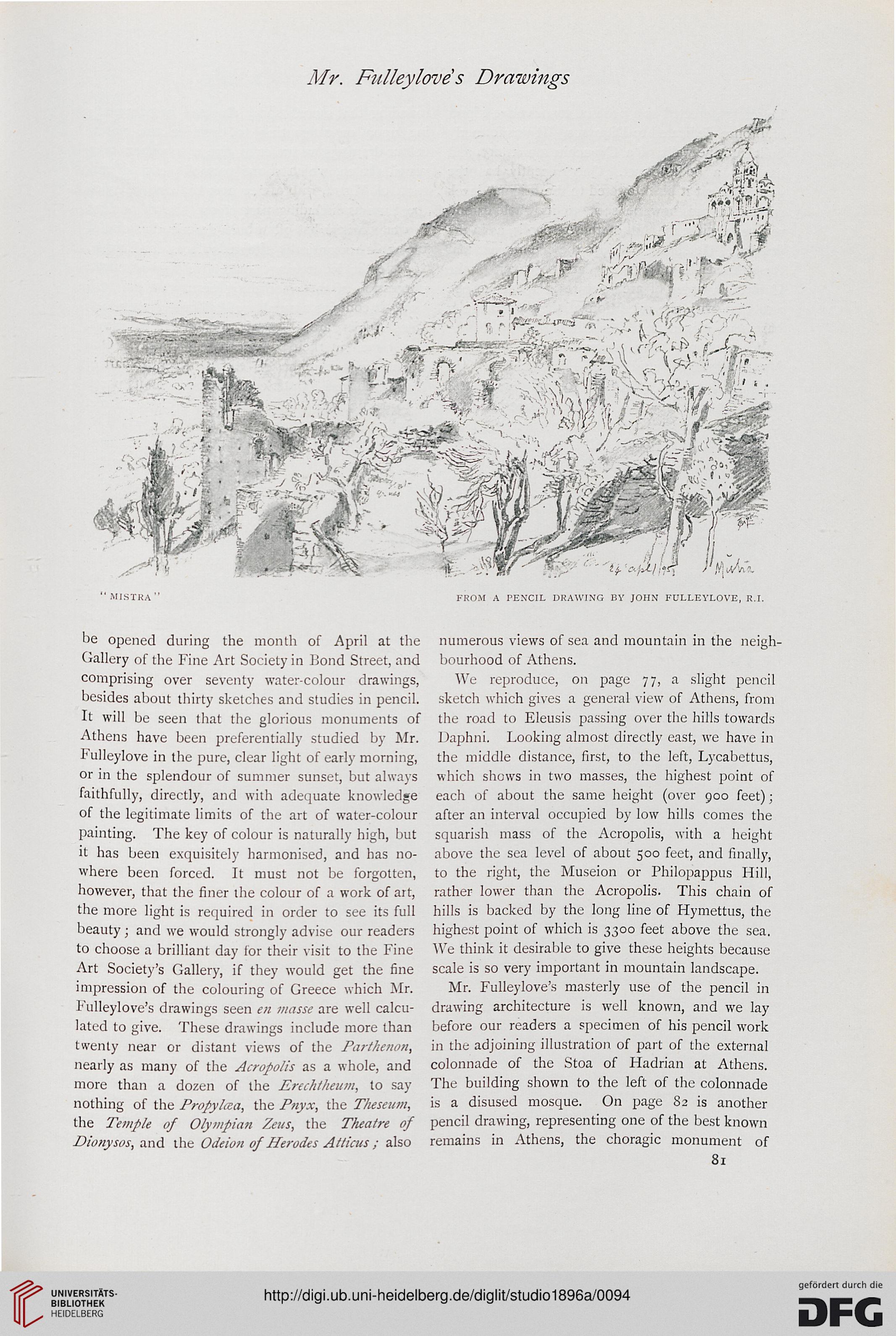Mr. Fulleylove's Drawings
"MISTKA" FROM A PENCIL DRAWING BY JOHN FULLEYLOVE, R.I.
be opened during the month of April at the
Gallery of the Fine Art Society in IJond Street, and
comprising over seventy water-colour drawings,
besides about thirty sketches and studies in pencil.
It will be seen that the glorious monuments of
Athens have been preferentially studied by Mr.
I'ulleylove in the pure, clear light of early morning,
or in the splendour of summer sunset, but always
faithfully, directly, and with adequate knowledge
of the legitimate limits of the art of water-colour
painting. The key of colour is naturally high, but
it has been exquisitely harmonised, and has no-
where been forced. It must not be forgotten,
however, that the finer the colour of a work of art,
the more light is required in order to see its full
beauty ; and we would strongly advise our readers
to choose a brilliant day for their visit to the Fine
Art Society's Gallery, if they would get the fine
impression of the colouring of Greece which Mr.
Fulleylove's drawings seen en masse are well calcu-
lated to give. These drawings include more than
twenty near or distant views of the Parthenon,
nearly as many of the Acropolis as a whole, and
more than a dozen of the Erechtheum, to say
nothing of the Propylaa, the Pnyx, the Theseum,
the Temple of Olympian Zeus, the Theatre of
Dionysos, and the Odeion of Herodes Atticus ; also
numerous views of sea and mountain in the neigh-
bourhood of Athens.
We reproduce, on page 77, a slight pencil
sketch which gives a general view of Athens, from
the road to Eleusis passing over the hills towards
Daphni. Looking almost directly east, we have in
the middle distance, first, to the left, Lycabettus,
which shows in two masses, the highest point of
each of about the same height (over 900 feet);
after an interval occupied by low hills comes the
squarish mass of the Acropolis, with a height
above the sea level of about 500 feet, and finally,
to the right, the Museion or Philopappus Hill,
rather lower than the Acropolis. This chain of
hills is backed by the long line of Hymettus, the
highest point of which is 3300 feet above the sea.
We think it desirable to give these heights because
scale is so very important in mountain landscape.
Mr. Fulleylove's masterly use of the pencil in
drawing architecture is well known, and we lay
before our readers a specimen of his pencil work
in the adjoining illustration of part of the external
colonnade of the Stoa of Hadrian at Athens.
The building shown to the left of the colonnade
is a disused mosque. On page 82 is another
pencil drawing, representing one of the best known
remains in Athens, the choragic monument of
81
"MISTKA" FROM A PENCIL DRAWING BY JOHN FULLEYLOVE, R.I.
be opened during the month of April at the
Gallery of the Fine Art Society in IJond Street, and
comprising over seventy water-colour drawings,
besides about thirty sketches and studies in pencil.
It will be seen that the glorious monuments of
Athens have been preferentially studied by Mr.
I'ulleylove in the pure, clear light of early morning,
or in the splendour of summer sunset, but always
faithfully, directly, and with adequate knowledge
of the legitimate limits of the art of water-colour
painting. The key of colour is naturally high, but
it has been exquisitely harmonised, and has no-
where been forced. It must not be forgotten,
however, that the finer the colour of a work of art,
the more light is required in order to see its full
beauty ; and we would strongly advise our readers
to choose a brilliant day for their visit to the Fine
Art Society's Gallery, if they would get the fine
impression of the colouring of Greece which Mr.
Fulleylove's drawings seen en masse are well calcu-
lated to give. These drawings include more than
twenty near or distant views of the Parthenon,
nearly as many of the Acropolis as a whole, and
more than a dozen of the Erechtheum, to say
nothing of the Propylaa, the Pnyx, the Theseum,
the Temple of Olympian Zeus, the Theatre of
Dionysos, and the Odeion of Herodes Atticus ; also
numerous views of sea and mountain in the neigh-
bourhood of Athens.
We reproduce, on page 77, a slight pencil
sketch which gives a general view of Athens, from
the road to Eleusis passing over the hills towards
Daphni. Looking almost directly east, we have in
the middle distance, first, to the left, Lycabettus,
which shows in two masses, the highest point of
each of about the same height (over 900 feet);
after an interval occupied by low hills comes the
squarish mass of the Acropolis, with a height
above the sea level of about 500 feet, and finally,
to the right, the Museion or Philopappus Hill,
rather lower than the Acropolis. This chain of
hills is backed by the long line of Hymettus, the
highest point of which is 3300 feet above the sea.
We think it desirable to give these heights because
scale is so very important in mountain landscape.
Mr. Fulleylove's masterly use of the pencil in
drawing architecture is well known, and we lay
before our readers a specimen of his pencil work
in the adjoining illustration of part of the external
colonnade of the Stoa of Hadrian at Athens.
The building shown to the left of the colonnade
is a disused mosque. On page 82 is another
pencil drawing, representing one of the best known
remains in Athens, the choragic monument of
81




